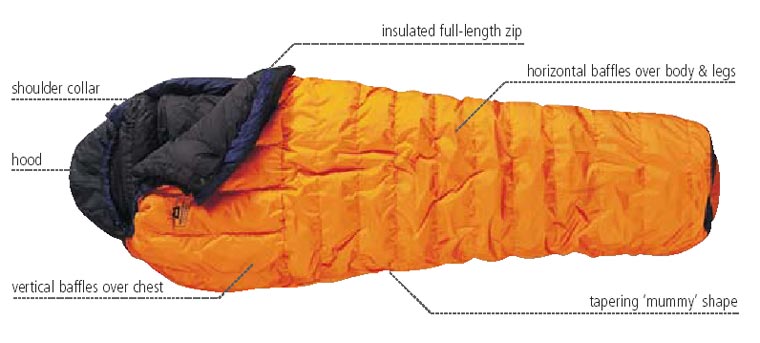
Guide to Sleeping Bags
Most of our trips, treks and expeditions will require you to have a sleeping bag. Choosing the right sleeping bag can be a bit daunting when faced with the huge array on sale, but the main focus for your decision will be on the filling and then the amount of fill depending on the lowest temperature you are likely to experience.
Sleeping bags keep you warm by trapping the warm air around you; your body creates heat and the warm air is trapped in the filling the same as a duvet on your bed. Air is a poor heat conductor but a great insulator.
Mountain sleeping bags are mummy-shaped, mostly with a zip and drawstring that keeps the top tight around you.
The sleeping bag can’t insulate you from below because your weight is compressing the material, so on cold terrain the bag is really only as good as the insulation provided from your mat.
There are two main types of insulation that the sleeping bag may use – synthetic and down.
Down insulation (the small down feathers from ducks and geese) is lightweight, durable and packs down well, but it’s more expensive. Wet down will not maintain warmth though, plus it’s difficult to dry once wet. Dry down is a recent innovation that coats the filaments of the feathers in a hydrophobic coating and helps keep the bag from getting damp.
Also there’s an ethical consideration since down is an animal by-product and there is plenty of evidence of inhumane treatment of the animals (ducks and geese). The ethical down standard is well worth reading when you are choosing a bag that uses ethical down.
Synthetic insulation is usually a bit heavier and bulkier, but will dry out better than down and do maintain some warmth even when damp. Recent innovations are more lightweight though and products like Primaloft, Thermolite, Climashield and Quallofil are examples of high-end synthetic insulation.
Synthetic fill comes in two types, short fibres and long filaments. Short fibres mimic the structure of a down feather but they break down quite quickly with use so don’t last long. Continual filaments are durable and provide good insulation but they don’t compress well.
The decision on which filling is right for you will, therefore, be decided by things like:-
- Weight and bulk on long trips Down is lighter and compresses well.
- Damp – might it get wet with no chance of drying? A synthetic bag drys better and keeps it’s warmth when damp.
- Cold – in very cold temperatures, a down bag has the best weight to warmth ratio
- Cost – down is more expensive but probably the better investment long term because it’s a durable bag. Synthetic bags are cheaper generally.
MORE ON DOWN INSULATION
Down insulation is available in different qualities, this depends on which bird it came from and what proportion of it is down vs feathers. Eider duck down is usually the best, goose down the next best and duck down slightly less so.
The proportion of down to feather may be specified as a percentage. For example, 90/10 would be 90% down, 10% feather; the higher the first number the better.
The down is also often given a ‘Fill Power’ rating. This is a measure of how much the down puffs up and traps the air that will insulate you. If it puffs up more, you need less of it to do the same job. Again, the higher the number the better, numbers of 750 or higher are good. Just to confuse things, tests results to the US system will come out higher than the European system. See this video of a US fill power test.
You should also check whether the down is responsibly sourced. Down clearly comes from birds and therefore the way in which the birds are reared and how the down is collected is of relevance. At one extreme, geese may have the down feathers plucked from their breast region whilst they are still alive. Some down is sourced from birds slaughtered for their meat and is gathered from the dead bird during processing.
Some manufacturers such as Tundra claim to only use down that has already been naturally moulted by geese that are reared for breeding purposes. The European Down and Feather Association have a code of practice, and Patagonia have also now produced a standard that they have committed to follow on the ethical sourcing of down for their clothing. We all have a duty to question manufacturers so that they are put under pressure to ensure that down is responsibly sourced.
SLEEPING BAG TEMPERATURE RATINGS
Different people will feel warmer or colder in exactly the same sleeping bag in exactly the same conditions. However, there is a measurement system that you can use to help guide you. Not all manufacturers will use this system but if the sleeping bag has EN13537 written on it next to the rating, then they are. See this Explanatory video on youtube.
The rating system does not give one number for the bag, it gives a range. These are summarised as follows:-
Upper Limit – the highest temperature at which somebody would be able to sleep in the bag with the zip open and their arms and head out. Hotter than this and they will be sweating and unable to sleep.
Comfort Temperature – the temperature at which somebody would sleep comfortably.
Lower Limit – the temperature at which somebody would still be able to sleep for 8 hrs without waking up due to the cold.
Extreme – the minimum temperature at which somebody would survive for 6 hrs without hypothermia.
The most useful temperature rating to use would probably be the Comfort rating. If you read what the sleeping bag is rated as and then make a decision based on your how much you feel the cold.
Example of a sleeping bag rating tag
Note that it is the “Comfort” temperature that is most useful, in this particular case it is +8 deg C. A lot of people would be uncomfortable sleeping at +3 deg C in this, bag and some would be on the verge of hypothermia at -11 deg C.
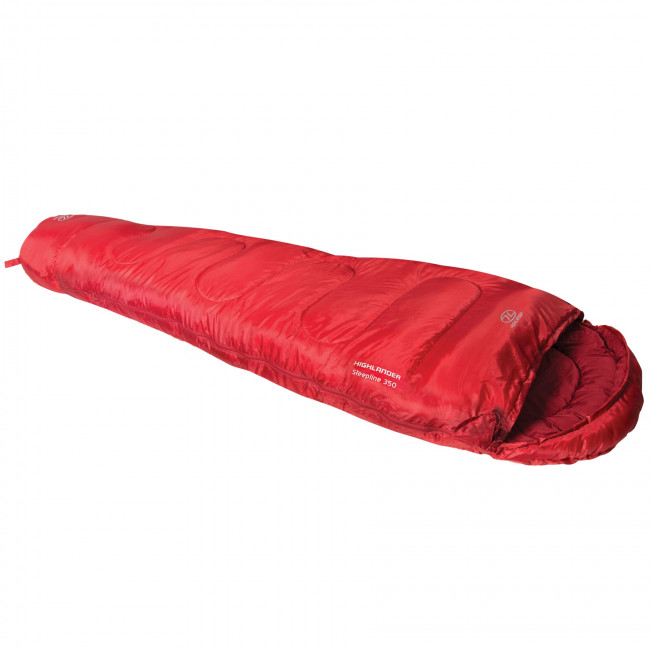
SEASON RATINGS FOR SLEEPING BAGS
Sleeping bags are rated by seasons to provide a generic comparison when buying. It’s a simple guide though, sleeping bags are an investment for the future and care should be taken to look at all the factors like type of fill, temperature rating, type of use and ethical considerations.
1 season – summer camping
2 season – UK late spring and early autumn,
3 season – autumn, early winter with no frost, mid-cold nights
4 season – cold winter nights with frost, high altitude
5 season – extremely cold, polar conditions and high altitude
SLEEPING MATS
As mentioned above, a sleeping bag only really insulates you from the air around you, not from the ground beneath you. This effect can be enormous and even the best sleeping bag is likely to be useless without an appropriate mat, especially if you are camping on rock, snow or ice. You must have an appropriate mat in conjunction with your sleeping bag.
There are two main types of sleeping mat; Closed Cell Foam and Inflated/Self-Inflating.
Closed-Cell Foam Mats are the traditional old-school camping mats. These are very light but quite bulky and limited in their insulating properties. Their huge advantage is that they are robust and will still work if they are punctured by a knife, thorn, crampon etc. they can also be used immediately with no need to inflate them.
Inflated Mats will generally pack much smaller but may be slightly heavier. They can, however, be made much thicker and can, therefore, be much more comfortable and much more insulating, especially if they contain down insulation as well as air. The big potential disadvantage with these mats is that they are useless if they are punctured. It is therefore essential that you carry a repair kit for them. Also, bear in mind that blowing them up with your mouth will put some moisture inside them. This is not generally a problem, but if you are in a cold location this may turn to ice and build up inside. It will also start to affect the performance of any down filler inside.
On high altitude mountain climbs, we will normally carry both a closed-cell mat and an inflating mat.
SLEEPING BAG LINERS
These are usually made of silk or synthetics (like microfiber or polyester), cotton or fleece. Fleece and silk are insulating and add a few degrees to the warmth of a bag, while the cotton ones or synthetic ones are useful for keeping your sleeping bag clean inside.
The fleece ones are quite bulky but very useful where you might be sleeping in a variety of temperatures. For example on a big mountain you might have a four season bag for the high cold camps, but at base camp it is much warmer. In which case sleep in the fleece liner and use the sleeping bag as a duvet.
Silk liners are obviously lighter and pack down smaller, and they are also warm but not as warm as a fleece liner.
Cotton liners are great for jungle trips where it is hot and humid and you don’t even need a sleeping bag. They’re much easier to launder than a whole sleeping bag if you want them as a liner, and they’re great for hostels and indoor use.
Some synethic liners are quite advanced, they use a hollow-core Thermolite fibre and a three-dimensional knitted structure which traps air nicely and they can be used as a standalone sleeping bag.
SLEEPING BAG SHAPE AND SIZE
Not all sleeping bags are the same length and width. If you are tall, wide, have an aversion to tightness or have a particular way of sleeping, you may want to check the dimensions of the sleeping bag and maybe even ask to open one out in the shop.
There are a few different shapes of sleeping bag available. The simple rectangular ones are cheap for a reason! They are not really useful for mountain conditions.
A ‘mummy’ shaped bag is the norm as it works more efficiently in that it traps air for insulation purposes within the wall of the bag but does not have excessive pockets of air between you and the inner wall of the bag. These pockets of air can make it take longer to get warm and cool down more easily.
Mummy shaped bags also make more efficient use of material and are therefore lighter and less bulky for the same overall size. Some people find the narrower or more shaped fit a bit constrictive, particularly if you happen to have wide shoulders or a particular body shape.
There are also some new ‘pod’ shaped sleeping bags that are much wider and allow you to curl up inside them and sleep in a variety of shapes. This may work well for general comfort but does make for a much bulkier bag and so is not likely to be particularly well suited to travel where weight and bulk of the packed bag is a factor.
Some models will have certain features to try and improve performance. These might include the shape, size and layout of the pockets in which the insulation is distributed, particularly with regard to avoiding cold spots where insulation may not be well distributed. A well-shaped hood that can close down around your face and keep you comfy is very important in cold conditions. Another feature that can be very useful is a baffle that can be independently closed up around your neck to fit the bag to your body shape and avoid any draughts.
As with a lot of cheaper clothing, cheaper sleeping bags may have lower quality zips and zip detailing. The last thing you want is not to be able to close your bag if the zip is broken or swallows up a wad of fabric and jams. Good bags will also have a baffle on the inside of the zip so that you don’t get a strip of cold along with it.
You can use silk, cotton or fleece sleeping bag liners to help keep the bag clean and also get a few degrees more of warmth.
Looking After Your Sleeping Bag
As with all kit, it will continue to perform well for longer if you look after it. When not in use it is best stored laid out flat in a dry place. It should not be left in its stuff sack and ideally not hung up. Some sleeping bags come with a small stuff sack for using on a trip and also a much larger cotton bag for storage at home.
Washing your sleeping bag is possible, see video from Trail Magazine, but will inevitably reduce its performance of done too often. If you use a liner then this can help reduce the need for washing. If you do need to wash it then you need to do it carefully by hand using special washing liquid that won’t leave a residue. You can then tumble dry it on a low heat setting, although your machine is unlikely to be big enough for a 4 or 5 season bag. Adding a tennis ball to the drier can help to break up and ‘clumps’ and help to re-loft down.
When carrying/using your sleeping bag you should try to keep it dry at all costs. Carry it in a waterproof stuff sack. In addition to rain, snow and rivers, the bag can get damp from steam from a stove or drips/ice crystals falling off the inside of a tent. If it gets damp then air it at the first opportunity. Using a gore-tex outer bag can be useful in certain environments and some bags come with a water-resistant outer shell material. Beware though, some of these outer shells can also be quite air-tight. Therefore if the bag is fully puffed-up and you jump on it you can damage the stitching or even pop it like a balloon!
When you get your sleeping bag out of its stuff sack it will need some time to ‘loft’ or ‘puff-up’ before it is at its best. Therefore it is wise to lay out your sleeping bag at least an hour or so before you get into it.
Suggested Sleeping Bags for some of our trips
Please note that this is just a rough guide, as mentioned above, warmth can be very subjective. If you feel the cold then do go for a bag that is warmer (rated to a lower comfort temperature) or take some thermals or a silk/fleece/cotton liner as well. Do speak to us if you have any doubts or questions before spending your hard-earned cash on a new sleeping bag.
| Trip | Accommodation | Insulation Type* | Comfort Temperature** |
| Borneo treks | Lodges, homestays | Cotton liner (self made) | 10 deg C |
| Mount Kenya | Huts and tents | Synthetic | -5 to -10 deg C |
| Nepal treks | Lodges | Synthetic | -5 deg C |
| Mount Toubkal | Mountain refuge, tents | Synthetic or Down | -5 deg C (winter) , 0 deg C (summer) |
| Mount Kilimanjaro | Tents | Synthetic or Down | -10 deg C |
| Ojos del Salado | Tents and hut | Down | -15 deg C |
| Elbrus South Route | Mountain hut | Synthetic or Down | -5 deg C |
| Elbrus North Route | Tents and hut | Down | -20 deg C |
| Island Peak | Lodges and tents | Down | -15 deg C |
| Mera Peak | Lodges and tents | Down | -15 deg C |
| Mount Aconcagua | Tents | Down | -20 deg C |
| Mount Everest | Tents | Down | -40 deg C or lower |
* This assumes general material specifications. High-grade synthetics can out-perform low grade down and may be more appropriate in case of extreme allergies or locations where there may be significant moisture or potential condensation and ice buildup.
** This is only a guide and assumes that the sleeping bag has been graded according to EN13537. Also, ensure that you read the right part of the sleeping bag rating tag or description, some marketing literature can be misleading and quote the Lower Comfort Limit, what is given here is the Comfort Temperature, see section above on ratings for an explanation.
Sleeping bag rentals
All the sleeping bags that we rent for Mount Kilimanjaro and Mount Elbrus are Highlander Serenity 350 or 450 synthetic bags which are 4 season and weigh 2kgs and have a spiral hollofil synthetic fill and a comfort rating down to -4 deg C.
Sleeping in Borneo
Our trips to Borneo generally involve sleeping in riverside lodges, chalets or homestays when you are not in a hotel. In all these places there will be a mattress on the floor with a mosquito net provided. It is hot and humid so you will not want a heavy sleeping bag; instead we use a cotton sleeping liner, basically a cotton bed sheet made into a sleeping bag shape.
Book Your Adventure of a Lifetime Now
Discover our trips to other Countries
Adventure Alternative Articles
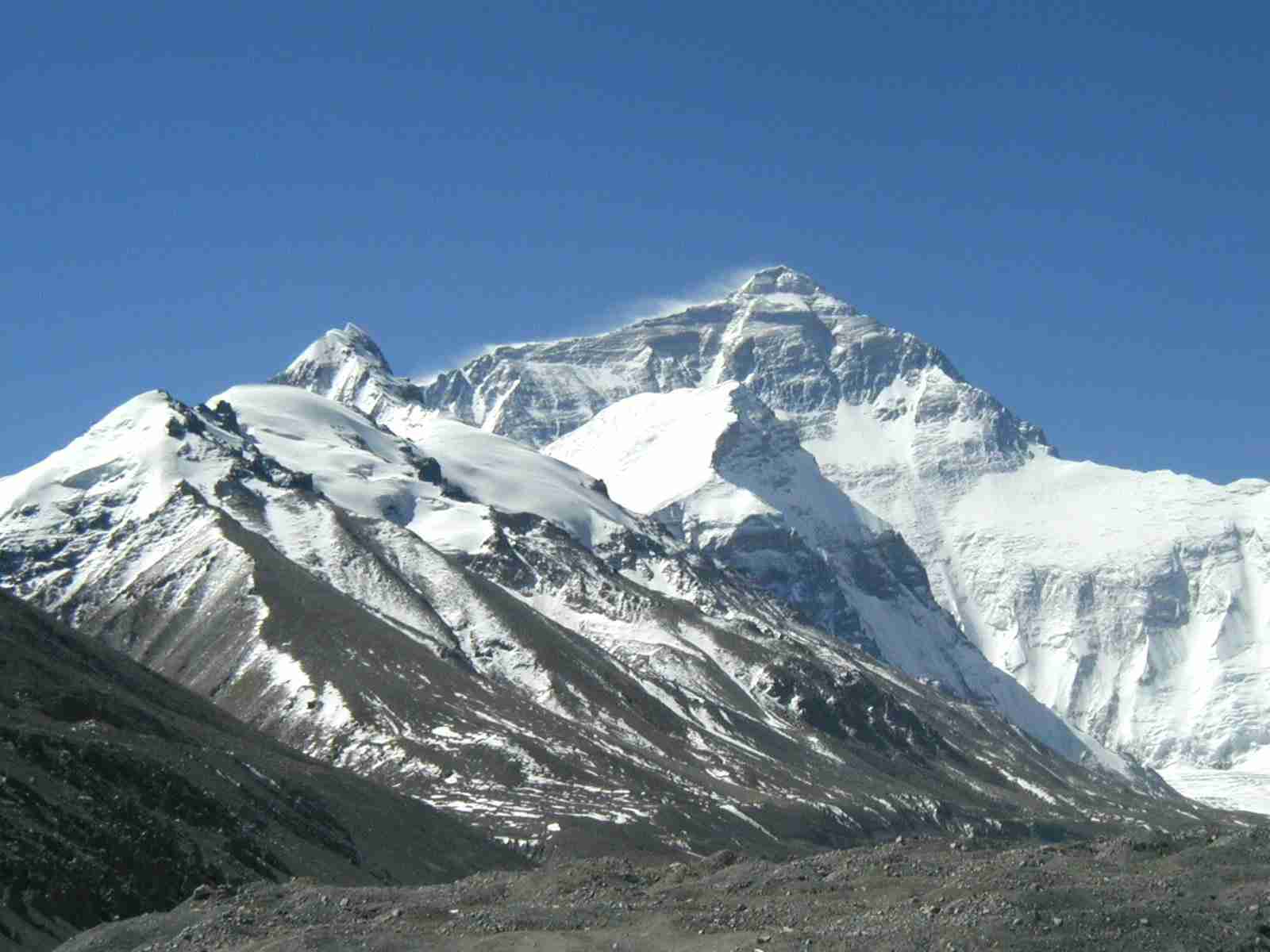
12 MONTHS, 12 MOUNTAINS
Climbing Calendar Ready for World Mountain Day In celebration of World Mountain Day, we've created a calendar for the year to make it easy for...
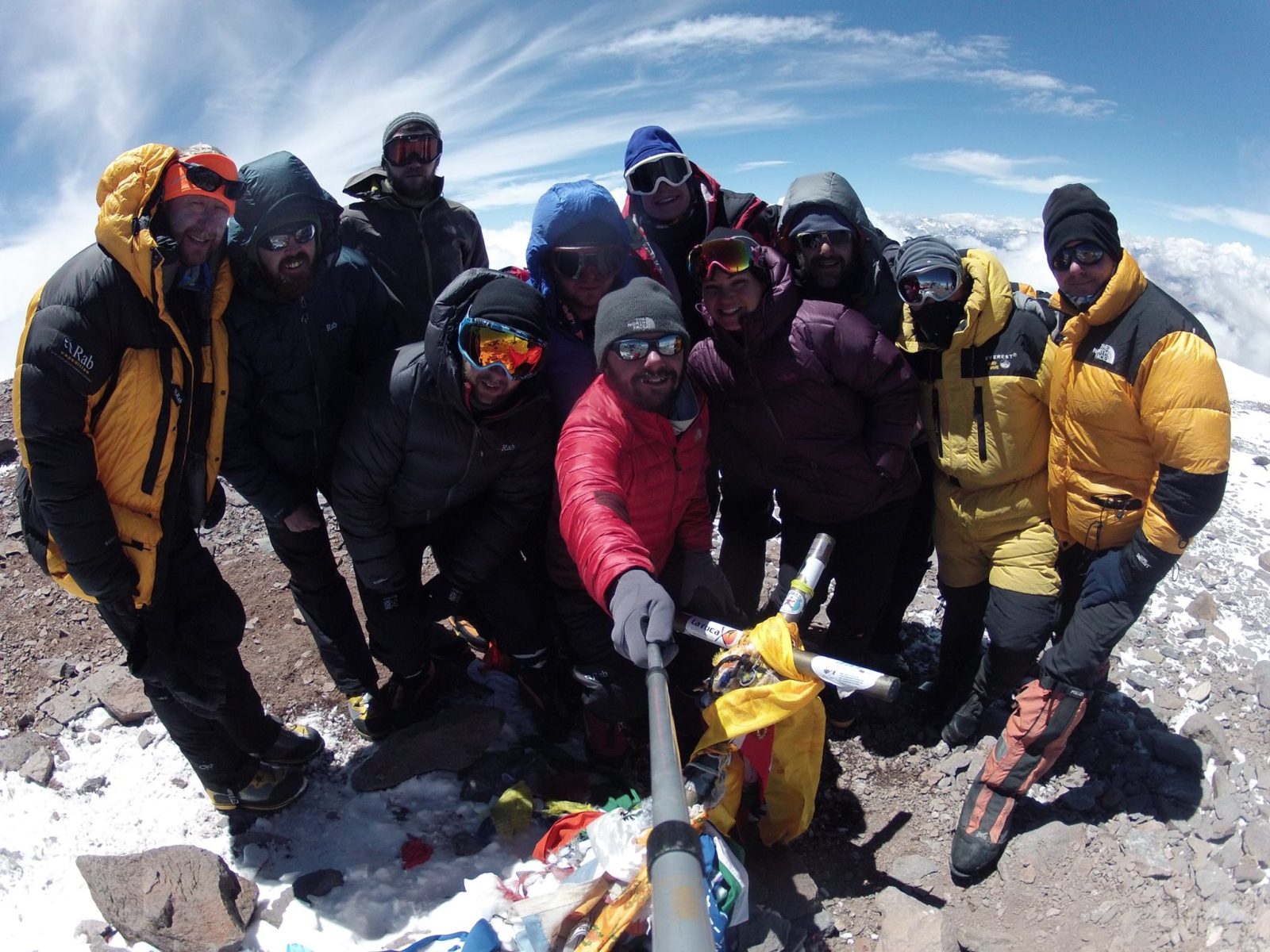
Mount Aconcagua Trip Review
January 2016 This year we had a team of twelve clients from four different countries – Iran, Ireland, England, South Africa and Argentina –...
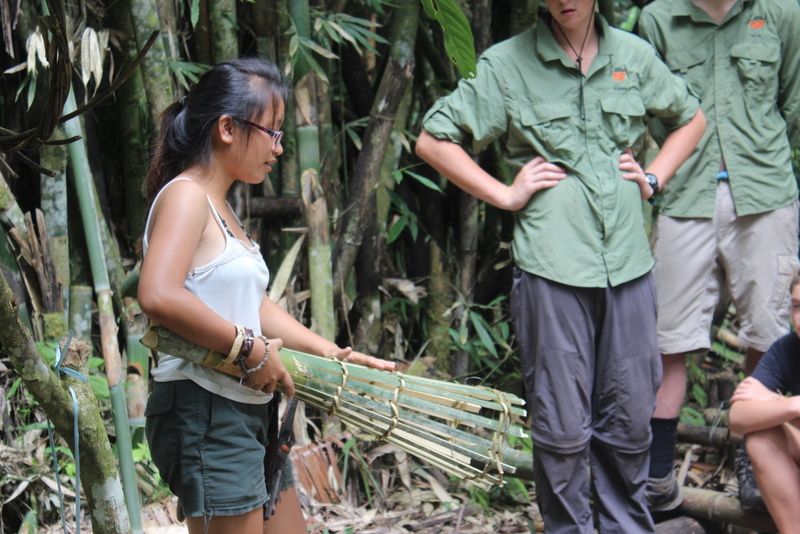
Alcey’s Survival Skills Course at Lupa Masa Jungle Camp
SURVIVAL SKILLS COURSE AT LUPA MASA JUNGLE CAMP | ADVENTURE ALTERNATIVE In celebration of International Rural Women’s Day, we’re talking...